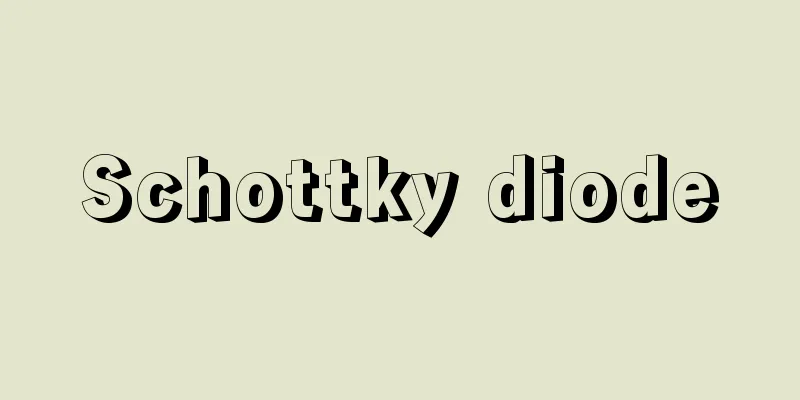Schottky diode

|
A diode that utilizes the rectification effect that occurs at the contact surface between a metal and a semiconductor. The same type of rectification effect is also used in cuprous oxide rectifiers, selenium rectifiers, and crystal detectors, which have been used for a long time. When a metal comes into contact with a semiconductor, even at room temperature, thermionic emission occurs from the metal to the semiconductor, creating an energy barrier. In addition, electrons move from the semiconductor side to the metal by diffusion, creating a potential difference within the semiconductor. Therefore, in the forward direction, with the semiconductor side negative, electrons in the semiconductor flow to the metal side, but in the reverse direction, only a small amount of electrons due to thermionic emission flow from the metal side to the semiconductor side, creating a rectification effect. This effect was theorized by Walter Hans Schottky (1886-1976) in 1938 and is called the Schottky effect. Since it utilizes this effect, it came to be called a Schottky diode. Large-area power diodes can handle a current of several tens of amperes at a forward voltage of about 0.5 volts, but their reverse withstand voltage is low at about 30 volts. The forward current is the flow of electrons from the semiconductor to the metal, and there is no injection of minority carriers (holes in this case) into the semiconductor, so there is no accumulation of minority carriers and the response speed when the diode is switched is fast. Because of this low forward voltage loss and fast response speed, they are used to improve the switching characteristics of integrated circuits, etc., and are also used in ultra-high frequency receivers. For high power applications, they are used for rectifying low voltage, high current, and high frequency AC up to about 200 kHz. The semiconductor used in diodes is sometimes gallium arsenide (gallium arsenide) in radio telephone repeaters and television receivers, but n-type silicon is often used for power applications. The metal used in this case is often aluminum or chromium. [Masatoshi Mitaka] [Reference item] |Source: Shogakukan Encyclopedia Nipponica About Encyclopedia Nipponica Information | Legend |
|
金属と半導体の接触面に生ずる整流作用を利用するダイオード。古くから使われている亜酸化銅整流器、セレン整流器、鉱石検波器なども同種の整流作用を利用している。金属が半導体に接触すると、室温においても金属から半導体に向かって熱電子放出があり、これによりエネルギー障壁ができる。また、半導体側からは拡散によって金属に向かって電子が移動し、電位差が半導体内に生ずる。したがって、半導体側を負にした順方向では、半導体中の電子が金属側に流れるが、逆方向では、熱電子放出による電子がわずかに金属側から半導体側に流れるだけとなり、整流作用が生じる。この働きは、1938年ショットキーWalter Hans Schottky(1886―1976)が理論づけたもので、ショットキー効果といわれ、この働きを利用したことからショットキーダイオードとよばれるようになった。 電力用の大面積ダイオードでは、順方向電圧0.5ボルト程度で数十アンペアの電流が流せるが、逆耐電圧は30ボルト程度と低い。順方向電流は半導体から金属への電子の流れだけとなり、半導体への少数キャリア(この場合は正孔)の注入はないので、少数キャリアの蓄積がなく、ダイオードをスイッチしたときの応答速度は速い。このように順方向電圧損失が少なく応答速度が速いので、集積回路などのスイッチ特性向上に用いられるほか、超高周波受信機などにも使われている。また、大電力用としては、低電圧大電流の整流や200キロヘルツ程度までの高周波交流の整流に使われている。ダイオードに使う半導体は無線電話中継装置やテレビ受像機などでガリウムヒ素(ヒ化ガリウム)を使うこともあるが、電力用にはn形シリコンが多く使われる。このときの金属はアルミニウムまたはクロムを使うことが多い。 [右高正俊] [参照項目] |出典 小学館 日本大百科全書(ニッポニカ)日本大百科全書(ニッポニカ)について 情報 | 凡例 |
Recommend
Bear trees
… They live alone in forested areas and have a va...
Cyclea insuloris (English spelling)
...The ingredients are cephalatine, berbamine, me...
Plastron
…the central row of bones is formed by the fusion...
Toneri of the sword - Toneri of the sword
He was also called Tatehaki or Tatewaki no Toneri,...
Cologne
…A city in the state of North Rhine-Westphalia in...
Spoken language - Onseigengo (English)
A language in which speech sounds are spoken and u...
Funo [village] - Funo
A village in Futami County in northern Hiroshima P...
Many shrines - Ojinja
…According to the Kojiki and Nihon Shoki, the anc...
Money-like assets - Money-like assets
…Some securities, especially bonds with short mat...
Oxya japonica japonica (English spelling) Oxyajaponicajaponica
…[Tokuji Chiba]. … *Some of the terminology that ...
Jayasthiti Malla
...Brahmans who had escaped from the hands of Mus...
Air dome (English spelling)
A type of air-membrane structure. It is made by in...
Aguayo - Aguayo
…It is the center of a fertile agricultural regio...
Incisor - Itokiriba
〘 noun 〙 (from the fact that they are used to bite...
Anosmia - Anosmia
...Smells other than the original odor occur when...









